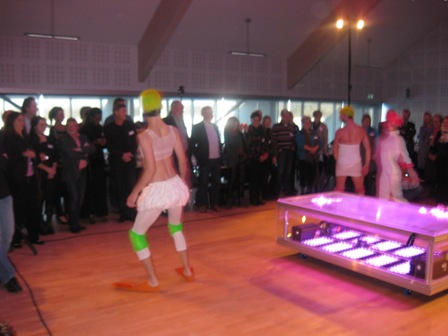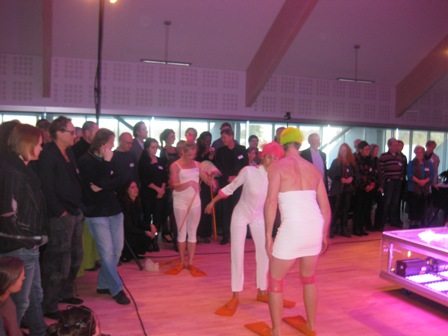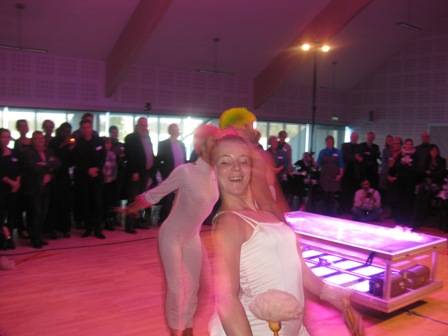Dance with the senses: Ingrid Kristensen




The dance performances of Ingrid Kristensen and her group I witnessed for the first time at a conference held in Sonderborg 14.December 2010. I was intrigued by her emphasis upon the interplay between dance and senses. Since it includes a strong component of audience participation with sweets to taste and perfumes to smell being passed around while watching the performance, it raises many philosophical questions about sense perception. This can be linked to her experimentation on a dance platform specially constructed so as to allow for the illumination of features, structures and forms.
Moreover, in discussions with Ingrid Kristensen after the performance, I discovered a person with profound knowledge and human depth. Her understanding of what it takes to transform dance into something being more than a mere performance, depicts a new way to tell a philosophical story. She does so in such terms which gives everyone an easy access to the thought processes behind such an art performance. That is especially convincing for those who sometimes have the illusion art is made without thoughts.
Altogether her approach can take dance further both as a technique and as a composition.
For instance, she has taken this 'dance of, for and with the senses' still further in 2012. Alone the images of some very intense and active days as shown on her blog touch upon those magic moments when conjured images appear in front of the eyes of the audiences. Always there is some disbelief in play. That sets things apart from a trivial reality.
http://ingrid-kristensen.dk/nyheder/ingrid_kristensen_photoblog/Sider/Sensing_Performances.html
How then to advance a philosophical discussion about dance? As already pointed out by Jadwiga Majewska in Polen, there is a need to develop a new language in order to perceive what experiences people make in the real world i.e. off stage. Such a language linked more to dance theatre can bring to light the variety of experiences people make. That can become as well a kind of diagnosis of the times we are living through at the moment. Many people are trying to figure out where to go and what to do with their lives marked by childhood being quickly over and without ever having understood deep enough the sadness inside which prevented one when a child to really play with the other children. That weighs still down the emotions when an adult. However some orientation can be obtained through the senses when comparing concepts of a mature life with what are these childhood like images often encountered in fables and other stories. By transferring both into virtual realities Ingrid Kristersen makes visible some escape routes.
As to the question of the senses, there is this long standing and very old philosophical debate between Hegel and Jacobi. Hegel denied what Jacobi claimed as being the 'certainty of the senses' and stated that neither the senses or poetry can be a source of truth. That would mean relying solely upon the concepts and what moves through them in terms of an 'unmoved mover' suggesting that there is an absolute spirit when in fact Hegel meant death itself. The latter amounts to a denial of life itself. It is at the root of so much mistrust when people become someone else once they relate only to the abstract order of things as defined by the state.
Naturally this discussion has to be extended to include someone like Jean Amery who wrote about the trust in the senses as long as the immediate and the mediate, the physical world and the language (dialect) used to describe common meanings meant a language shaped by a cultural affinity to the immediate surroundings. They could be verified by everyone having the freedom to experience them without the need of any mediation. It is only the abstract order with a written version of reality which makes it so difficult to know what is the place of the senses when orientation is now only structured according to symbols and figures, street lights and administrative decrees. The very fact that someone exists only if he has a passport and an identity which is registered by the state's administration or more precisely its police makes it all the more macabre. Brecht would denote the human being without passport does not exist and made that experience when he had to flee into exile.
But to come back to Ingrid Kristensen's performance, there has to be added something else. In today's world, there can be experienced a transmission of light when seeing people in the streets compared to videos uploaded onto youtube. Here the work of Ingrid Kristensen is outstanding. For she filters in her dance performances this transgression from the one plane of reality to that of the new media. She does so by allowing the dancers to enter the maze of the new world. By retaining a childhood like distance to these new encounters she keeps up a flow of imagines which run through the spine of the people watching like the electric current through the plastic tupes which illuminate the dancing space. It seems that there is a need to uphold a simple naivity as response to a world at risk to be outdistanced by the very technology it has developed. She does so by letting the audience go up close to these transitions. They make the senses dance in front of their eyes while experiencing something richer than what a mere distraction could achieve.
After her visit to Athens in May 23 - 25, 2012, she indicated in a letter how she thinks to continue with her dance sculptures demanding a lot of work and dedication but also thought through concepts:
"...the dance concrete sculpture has begun to require a whole lot of attention. I held auditions yesterday with the last dancer for the Company's performance in Sensing ... she is beautiful and works also in Berlin.
Here is the link to one of the installations we will present in Sensing come the month of August. When looking at the images you might only see the entire aesthetic with less colours but richer and closer to the warmth of the human body and soul. You have to think some of it addressing the senses through the dancers, or by the audience senses becoming themselves active ...." (May 30, 2012)
http://ingrid-kristensen.dk/homeeng/ingrid_kristensen_ietm.html
What is so novel and important about the 'danse with the senses' is that especially in a digital age there is still another risk to what was already a problem for philosophers in the nineteenth century when nationhood and the abstract concept of the state demanded that people no longer orientate themselves concretely, but along a path towards ever more abstract entities whether or not they could be filled with life or more likely with all the dead bodies caused by the wars due to such fear being created by people without sense orientation.
Hatto Fischer
27.9.2012
I N G R I D K R I S T E N S E N
» M o m e n t s o f M a g i c «
http://www.facebook.com/pages/Ingrid-Kristensen/182399401771507
« Jadwiga Majewska | Dance installation and discussions »
